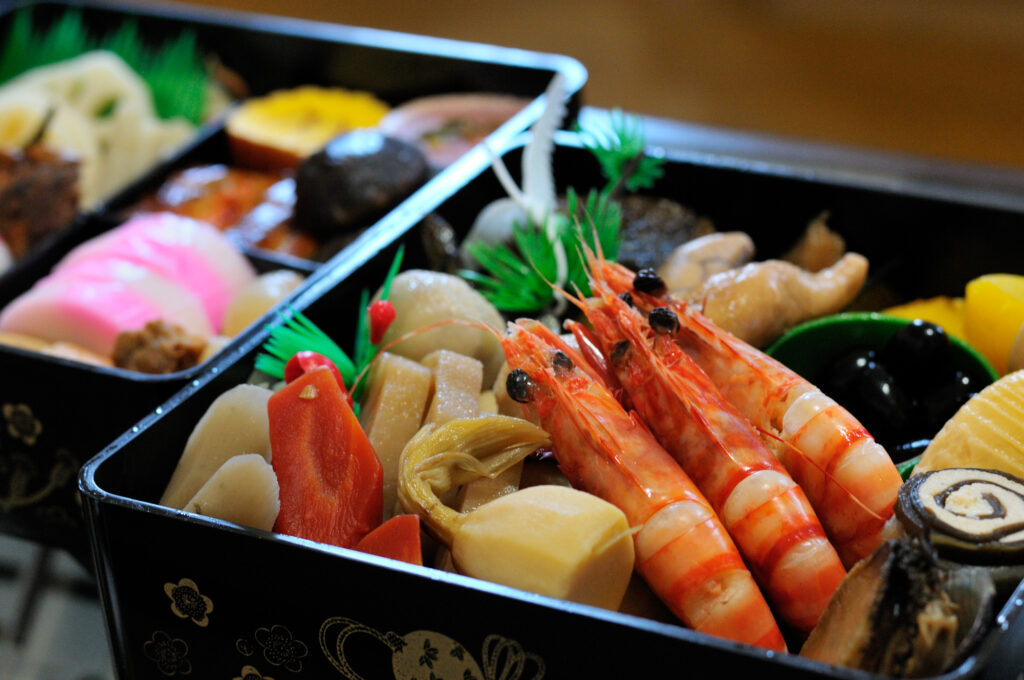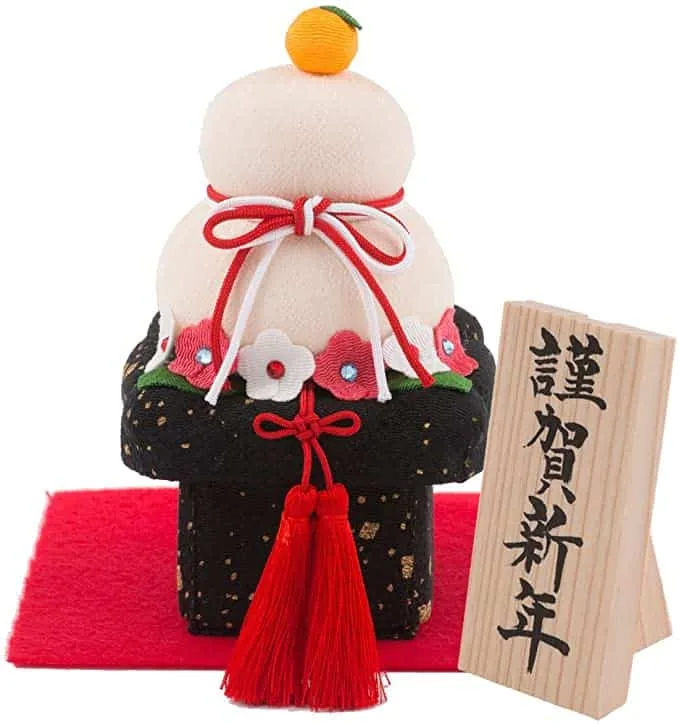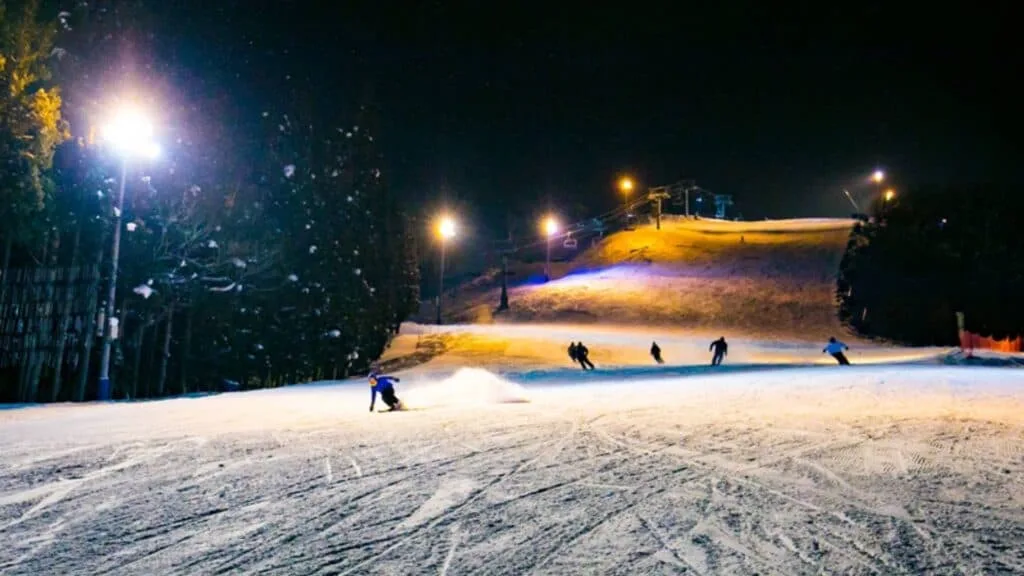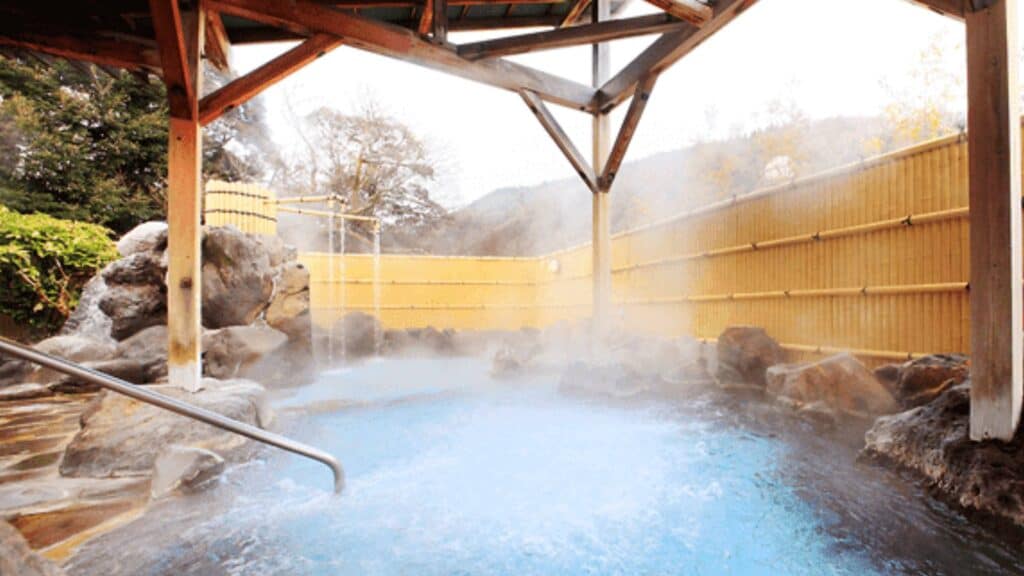January in Japan kicks off the year with a mix of cold-weather activities, deep-rooted traditions, and comforting winter foods. From serene temples bustling with New Year rituals to powdery slopes perfect for skiing, January has plenty to offer for travellers and locals alike. The winter chill adds a crisp backdrop to everything, making it a great time to explore, eat, and experience the start of a new year in Japan.
Temples and shrines are at the heart of New Year celebrations, with hatsumōde, the first visit of the year, bringing people together to pray for health and happiness. Popular spots like Tokyo’s Meiji Shrine and Kyoto’s Fushimi Inari Taisha see large crowds, but quieter local shrines also play a meaningful role in welcoming the new year.
For those seeking adventure, Japan’s snowy regions offer world-class skiing and snowboarding. Hokkaidō’s fine powder attracts enthusiasts from across the globe, while areas like Nagano and Niigata provide breathtaking winter landscapes and excellent conditions for outdoor fun. A visit to an onsen surrounded by snow is the perfect way to unwind and soak in the natural beauty.
Winter cuisine takes centre stage in January, with dishes that provide warmth and comfort. Ozōni, a mochi-filled soup, and nabe hot pots packed with fresh, seasonal ingredients are quintessential favourites. Sweet treats like taiyaki, a warm, red-bean-filled pastry, are especially satisfying on a cold day.
January in Japan is a time to embrace new beginnings, whether through thrilling adventures in the snow, cherished traditions, or simply enjoying the season’s flavours. It’s a month that invites both celebration and reflection, making it a special time to visit.
Starting the Year: New Year’s Traditions and Celebrations
January kicks off with Shōgatsu, Japan’s New Year holiday, which is one of the most significant times of the year. The celebrations blend age-old rituals with family gatherings, offering a deep cultural insight into how Japanese people embrace the new year.
Hatsumōde: A Meaningful First Visit to the Shrine

In early January, shrines and temples across Japan welcome waves of visitors participating in hatsumōde, the first shrine or temple visit of the year. This ritual involves offering prayers for good health, happiness, and prosperity in the coming months.
Popular shrines like Meiji Shrine in Tokyo and Fushimi Inari Taisha in Kyoto see particularly high foot traffic during this time, but smaller local shrines also play a vital role in communities. Many visitors purchase omamori (amulets for protection) or write their wishes on ema (wooden plaques), leaving them behind as part of their prayer ritual.
Osechi Ryōri: New Year’s Feast of Good Fortune

One of the highlights of Shōgatsu is osechi ryōri, a traditional meal served in elegant lacquer boxes. Each dish symbolises a wish for the upcoming year, such as kurikinton (sweet chestnut and sweet potato mash) for wealth, kazunoko (herring roe) for prosperity, and kuromame (black beans) for good health. Families gather to enjoy these dishes together, emphasising the holiday’s focus on unity and renewal.
Kagami Biraki: The Mochi-Breaking Ceremony

By mid-January, the tradition of kagami biraki marks another important cultural moment. Decorative rice cakes called kagami mochi, often displayed in homes during the New Year, are broken and shared among family members. The act of breaking the mochi symbolises strength and good fortune, and the rice cakes are typically enjoyed in dishes like ozōni, a warm soup perfect for the season.
Winter Scenery and Activities: Japan’s Snowy Side
January is peak winter in Japan, and many regions transform into magical snow-filled landscapes. Whether you’re an outdoor enthusiast or someone who enjoys the serene beauty of the season, there’s an abundance of winter activities and sights to discover. From exhilarating sports to unique wildlife encounters and moments of peaceful relaxation, Japan’s snowy side offers something for everyone.
Skiing and Snowboarding in Powder Paradise

Japan is a dream destination for skiing and snowboarding, boasting some of the finest snow conditions in the world. Renowned for their light, powdery snow, resorts in Hokkaidō, such as Niseko and Furano, attract enthusiasts with their pristine slopes and breathtaking mountain views. Central Japan is equally impressive, with Nagano’s Hakuba Valley and Shiga Kōgen offering expansive ski areas, suitable for everyone from beginners to seasoned professionals.
The facilities are world-class, with well-maintained runs, modern lifts, and cosy lodges. Visitors can even enjoy après-ski activities like sampling local delicacies or soaking in nearby onsen. January’s cold and stable weather creates the ideal environment for a memorable day on the slopes, with the added benefit of smaller crowds compared to February’s busier ski season.
Jigokudani: The Famous Snow Monkeys

For an extraordinary winter experience, a visit to Jigokudani Monkey Park in Nagano is a must. Here, Japanese macaques, better known as snow monkeys, spend the frosty months soaking in natural hot springs. Surrounded by a snowy landscape, the sight of these playful animals lounging in the warm water creates a charming and almost surreal scene.
Visitors can walk through the picturesque snow-laden forest to reach the park, adding to the sense of adventure. Watching the monkeys interact, from grooming one another to enjoying the steamy pools, offers a glimpse into their fascinating behaviour. It’s an encounter that combines nature, wildlife, and the distinctive charm of Japan’s winters.
Onsen: Relaxation Amidst Winter Landscapes

For those who prefer tranquillity to adrenaline, Japan’s onsen culture provides the perfect way to embrace the season. Onsen towns like Hakone, Kusatsu, and Beppu feature outdoor baths surrounded by stunning winter scenery. Soaking in the mineral-rich, steaming waters while gazing at snow-covered mountains or forests is an experience that soothes both the body and the soul.
January’s chilly temperatures enhance the pleasure of onsen bathing. The crisp winter air sharpens your senses, making the warm embrace of the hot spring water even more inviting. Many onsen also offer traditional ryokan stays, where guests can enjoy kaiseki cuisine, tatami rooms, and unparalleled hospitality, turning the experience into a complete retreat.
Snow-Centred Activities: Winter Fun for Every Traveller
January marks the height of snow season in Japan, and the country’s snowy landscapes come alive with possibilities for adventure, relaxation, and family-friendly fun. Whether you’re a seasoned skier, a photography enthusiast, or simply someone looking to embrace the magic of winter, Japan offers a wealth of activities to enjoy. From internationally acclaimed ski resorts to enchanting natural wonders and charming snow-filled villages, January is the perfect time to explore this winter wonderland.
1. Hitting the Slopes: Top Ski and Snowboard Destinations

For snow sports lovers, January in Japan is nothing short of paradise. The country’s renowned ski resorts boast some of the best powder snow in the world, combined with top-notch facilities, diverse terrain, and breathtaking mountain views. Whether you’re a beginner testing the slopes for the first time or an expert seeking challenging runs, these destinations promise unforgettable experiences.
Niseko, Hokkaidō
Niseko has gained international fame for its light, powdery snow and vibrant après-ski culture. With terrain suitable for skiers and snowboarders of all skill levels, as well as an array of off-slope activities like hot springs and gourmet dining, Niseko offers something for everyone. The stunning views of Mount Yōtei add a dramatic backdrop to your adventure.
- Getting There: Fly from Tokyo to Sapporo (approx. ¥10,000–¥15,000) and take a bus or train to Niseko (2.5–3 hours, approx. ¥4,000).
- Budget: Lift tickets start at ¥6,500 per day; accommodation ranges from ¥10,000 to ¥30,000 per night.
Hakuba Valley, Nagano
Famous for hosting events during the 1998 Winter Olympics, Hakuba is a hub of activity for snow sports enthusiasts. The valley features several interconnected resorts, each offering unique terrain and facilities. It’s an ideal destination for groups, with slopes catering to varying skill levels and plenty of après-ski entertainment in the surrounding villages.
- Getting There: Take the Hokuriku Shinkansen from Tokyo to Nagano (1.5 hours, approx. ¥8,000), followed by a bus to Hakuba (1 hour, approx. ¥1,500).
- Budget: Lift tickets cost around ¥6,000 per day; accommodation starts at ¥8,000 per night.
Nozawa Onsen, Nagano
Nozawa Onsen combines excellent skiing with a traditional Japanese village atmosphere. The town is renowned for its natural hot springs, or onsen, which are perfect for unwinding after a day on the slopes. Strolling through the charming streets, surrounded by snow-covered buildings, is a highlight of any visit.
- Getting There: Take the Hokuriku Shinkansen to Iiyama (1.5 hours, approx. ¥8,000), then a bus to Nozawa (40 minutes, ¥600).
- Budget: Lift tickets are around ¥5,500 per day; budget accommodation starts at ¥7,000 per night.
2. Picture-Perfect Snowy Scenery
Japan’s winter landscapes are a feast for the eyes, offering countless opportunities for photographers and nature lovers. From UNESCO World Heritage sites to unique wildlife encounters, January’s snowy vistas are as diverse as they are stunning.
Shirakawa-go, Gifu
Nestled in the mountains of Gifu Prefecture, Shirakawa-go is famous for its traditional thatched-roof houses, known as gasshō-zukuri. In January, the village is blanketed in snow, creating a picturesque scene straight out of a fairy tale. Evening illuminations, held on select nights, add a magical glow, making it an unmissable destination for photographers.
- Getting There: Take the Hokuriku Shinkansen from Tokyo to Kanazawa (2.5 hours, approx. ¥14,000) and a bus to Shirakawa-go (1 hour, approx. ¥2,500).
- Budget: Entry to the village is free; guided tours start at ¥4,000.
Jigokudani Monkey Park, Nagano
One of Japan’s most iconic winter sights, Jigokudani Monkey Park is home to Japanese macaques, or snow monkeys, who famously soak in the area’s natural hot springs. Surrounded by a snowy landscape, these playful creatures provide a one-of-a-kind wildlife photography opportunity.
- Getting There: From Nagano Station, take a bus to Kanbayashi Onsen (40 minutes, approx. ¥1,500). The park is a 30-minute walk from the bus stop.
- Budget: Entrance fee is ¥800.
3. Snow Activities for Beginners
Not everyone is drawn to the slopes, but that doesn’t mean you can’t enjoy Japan’s winter wonderland. For those new to snow activities, Japan offers a range of experiences that are both accessible and unforgettable.
Zao Onsen Snow Monsters, Yamagata
Zao is famous for its “snow monsters”—trees coated in layers of frost and snow that take on bizarre, otherworldly shapes. Guided snowshoeing tours provide a fun and easy way to explore this phenomenon, even for beginners. A ride on the Zao Ropeway offers panoramic views of the surreal landscape.
- Getting There: Take the Yamagata Shinkansen to Yamagata Station (2.5 hours, approx. ¥12,000), followed by a bus to Zao (45 minutes, approx. ¥1,000).
- Budget: Snowshoeing tours start at ¥5,000; lift tickets for non-skiers are ¥3,000.
Tomamu Ice Village, Hokkaidō
A magical winter attraction, Tomamu Ice Village features intricate ice sculptures, an ice skating rink, and tubing runs. The atmosphere is enchanting, especially in the evening when the area is illuminated. It’s perfect for those who want to enjoy the snow without strapping on skis.
- Getting There: Fly to Sapporo from Tokyo (approx. ¥10,000–¥15,000) and take a train to Tomamu (1.5 hours, approx. ¥3,000).
- Budget: Entry starts at ¥500; activities are individually priced.
4. Family-Friendly Snow Fun
Families travelling with children will find no shortage of options for winter fun in Japan. From snow parks to beginner-friendly ski resorts, there’s something to entertain visitors of all ages.
Karuizawa Prince Hotel Ski Resort, Nagano
This resort is perfect for families, offering a dedicated snow-play area with sledding and snow tubing. Short beginner slopes make it easy for kids to get started with skiing. For non-skiers, the nearby Karuizawa Prince Shopping Plaza offers a range of dining and shopping options.
- Getting There: Take the Hokuriku Shinkansen to Karuizawa (1 hour, approx. ¥5,500).
- Budget: Family packages start at ¥10,000 for lift passes and rentals.
Furano Ski Resort, Hokkaidō
Furano is a top choice for families, thanks to its excellent ski schools and fun snow activities like sledding. The resort also offers English-speaking instructors, making it particularly welcoming for international visitors.
- Getting There: Fly to Asahikawa from Tokyo (approx. ¥12,000) and take a bus to Furano (1.5 hours, approx. ¥2,000).
- Budget: Lift tickets start at ¥4,000; equipment rental starts at ¥3,000.
January Cuisine: Warming Dishes and Seasonal Ingredients
Winter in Japan brings a craving for hearty, comforting meals that warm both the body and soul. January is a prime time to indulge in dishes that celebrate the season’s chill and highlight the year’s first harvests. Whether it’s a communal feast or a simple bowl of something warm, Japanese winter cuisine offers a range of flavours and experiences.
Nabe: The Ultimate Winter Comfort Food

Nabe, a beloved hot pot dish, is the quintessential meal for cold winter evenings. Served bubbling at the table, it’s a communal tradition that brings friends and family together. Nabe can be customised with a variety of ingredients, including fresh vegetables, tofu, seafood, and meats, simmered in a rich broth.
Each region offers its own unique take on nabe. In Hokkaidō, kani nabe (crab hot pot) is a celebrated delicacy, featuring sweet, tender crab paired with seasonal vegetables. Further south in Kyūshū, motsunabe (offal hot pot) is a robust and flavourful dish that highlights local culinary traditions. No matter the variation, nabe is a warming, satisfying meal that’s perfect for sharing.
Mochi and Sweet Winter Treats
Mochi is a cornerstone of Japanese cuisine in January, deeply tied to New Year traditions. This chewy rice cake appears in a variety of forms during the winter months. Ozōni, a clear or miso-based soup featuring mochi alongside seasonal vegetables, is a staple New Year’s dish enjoyed across the country.
For those with a sweet tooth, mochi-based desserts are a seasonal highlight. Daifuku, soft mochi filled with red bean paste, and kinako mochi, mochi dusted with roasted soybean flour, are particularly popular in January. These treats offer a delicious balance of textures and flavours, celebrating the versatility of this humble ingredient.
Yuzu Citrus: A Burst of Freshness
January is yuzu season, and this aromatic citrus fruit adds a bright and refreshing note to winter dishes. Its tangy, slightly floral flavour is used to enhance everything from marinades and sauces to desserts like yuzu-flavoured cakes or sorbet.
Beyond the plate, yuzu finds its way into Japan’s winter wellness traditions. Yuzuyu, a hot bath infused with whole yuzu fruits, is popular in January, offering both relaxation and health benefits. It’s believed to improve circulation and help ward off colds, making it a seasonal favourite for body and mind.
January Weather in Japan: What to Expect

January in Japan brings cold, crisp air and a variety of weather across the country. From the snowy northern regions to the milder southern islands, the season offers clear skies and a true winter feel. Here’s what you can expect in different areas of Japan during January.
Hokkaidō: A Snowy Paradise
Hokkaidō, Japan’s northernmost island, experiences some of the coldest weather in the country, with temperatures ranging from -10°C to -1°C. Frequent snowfall blankets the region, making it ideal for winter sports and creating a beautiful wintry landscape.
Whether you’re skiing in Niseko or enjoying the snow festivals and hot springs, Hokkaidō’s January weather sets the perfect stage for outdoor adventures and cosy relaxation. Warm clothing, including thermal layers and snow boots, is essential to stay comfortable in the biting cold.
Tohoku: Winter at Its Best
In Tohoku, temperatures typically range from -5°C to 5°C, with snow-covered mountains and serene winter views dominating the scenery. This northern region is a favourite for snow sports, with destinations like Zao and Appi Kogen offering excellent skiing and snowboarding opportunities.
Beyond the slopes, the snow-covered hot spring town of Ginzan Onsen is a magical escape, while Zao’s “snow monsters” (trees covered in snow and ice) are a unique sight. Layered clothing and insulated footwear will keep you warm and comfortable while exploring.
Tokyo and Kanto: Clear and Cool
Tokyo and the surrounding Kanto region experience relatively mild weather in January, with temperatures ranging from 1°C to 10°C. Snow is uncommon, but frosty mornings and cool evenings give the city a crisp winter feel.
The clear skies make it a great time for sightseeing, with famous landmarks like the Tokyo Skytree and Mount Fuji often visible in the distance. Daytime walks through parks and gardens, such as Shinjuku Gyoen or Ueno Park, are pleasant, though a warm jacket and scarf are recommended for cooler moments.
Kyoto and Kansai: Mild and Dry
Kyoto and the Kansai region enjoy manageable winter weather in January, with daytime temperatures between 2°C and 11°C. The air is dry, and frost may appear in the mornings, adding a peaceful charm to the area’s famous temples and shrines.
Although snow is rare, the occasional dusting creates a stunning scene at places like Kinkaku-ji (the Golden Pavilion). Exploring Nara’s parks or strolling through Arashiyama’s bamboo forest is enjoyable with a warm coat and gloves to ward off the winter chill.
Okinawa: Warm and Relaxing
Japan’s southernmost islands of Okinawa provide a mild escape from the colder regions, with temperatures ranging from 15°C to 20°C. The weather is ideal for exploring the outdoors, hiking, or visiting cultural sites, though swimming at the beaches may be too cool for most visitors.
Light layers are typically enough to stay comfortable, and evenings may call for a light jacket. Okinawa’s mild January weather makes it a relaxing destination for those wanting to avoid winter’s bite.
What to Keep in Mind
- Dress in Layers: Weather varies widely across regions, so pack appropriately. A heavy coat is essential in colder areas, while lighter layers work for milder regions like Okinawa.
- Footwear: Waterproof boots are a must in snowy areas to keep your feet warm and dry.
- Clear Skies: Central and southern regions, such as Tokyo and Kyoto, are known for their bright and clear winter skies in January, making it a great time for sightseeing and photography.
Seasonal Events and Festivities
While New Year celebrations dominate the first week of January, the month is also marked by other meaningful events that highlight Japan’s deep-rooted traditions and communal spirit. From ceremonies honouring young adults to rituals that symbolise renewal, January’s festivities provide a fascinating glimpse into Japanese culture.
Seijin no Hi: Honouring Young Adults

Held on the second Monday of January, Seijin no Hi (Coming of Age Day) celebrates individuals who have turned or will turn 20 in the current fiscal year. This milestone is an important rite of passage in Japan, signifying the transition to adulthood.
Ceremonies are hosted by cities and towns across the country, with young men and women donning traditional attire. Women often wear furisode, an elaborate type of kimono with long sleeves, while men may opt for suits or occasionally hakama, a traditional garment. The day is filled with photo-taking, gatherings with family and friends, and reflections on new responsibilities as adults. The vibrant outfits and celebratory atmosphere make Seijin no Hi a joyous event that also underscores the value placed on milestones in Japanese society.
Dondo-Yaki: Burning New Year Decorations

By mid-January, shrines across Japan hold dondo-yaki, a ceremonial bonfire where New Year decorations and old talismans are burned. This ritual is believed to purify the past year and ensure good fortune for the year ahead.
Participants often write wishes or resolutions on wooden sticks or paper and add them to the flames, symbolically releasing their hopes into the universe. The sight of the crackling bonfire, often accompanied by warm communal gatherings, creates a reflective end to the festive period. Dondo-yaki not only marks the conclusion of New Year celebrations but also serves as a moment to reset and start anew.
Exploring the Winter Wonderland That is Japan in January

January in Japan is a time to experience the country’s serene and reflective side. The bustle of the New Year gives way to quieter streets and snowy landscapes, making it an ideal month for those seeking a mix of tradition, natural beauty, and winter warmth.
The chill in the air enhances the season’s atmosphere, whether you’re exploring temples busy with hatsumōde visitors, marvelling at snowy mountain vistas, or soaking in a steaming onsen surrounded by frost-covered trees. The absence of large crowds makes January an especially good time for sightseeing, with clear skies offering stunning views of landmarks like Mount Fuji.
Seasonal cuisine, from hot pots to sweet mochi treats, adds another layer of comfort to winter exploration. Together with the festive energy of events like Seijin no Hi and the reflective rituals of dondo-yaki, January offers a deeply rewarding experience that combines Japan’s cultural depth with the unique charm of its winter season.

